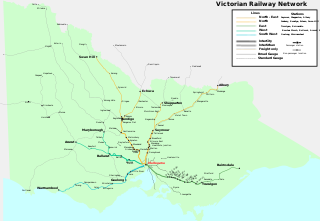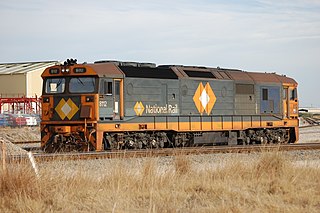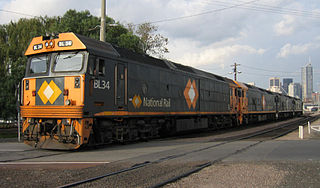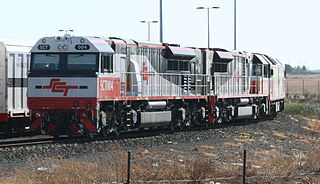| V/Line G class | |||||||||||||||||||||||||
|---|---|---|---|---|---|---|---|---|---|---|---|---|---|---|---|---|---|---|---|---|---|---|---|---|---|
 Pacific National G533 in February 2007 | |||||||||||||||||||||||||
| |||||||||||||||||||||||||
| |||||||||||||||||||||||||
| |||||||||||||||||||||||||
| |||||||||||||||||||||||||


The G Class are a class of diesel locomotive built by Clyde Engineering, Rosewater and Somerton for V/Line between 1984 and 1989.
| V/Line G class | |||||||||||||||||||||||||
|---|---|---|---|---|---|---|---|---|---|---|---|---|---|---|---|---|---|---|---|---|---|---|---|---|---|
 Pacific National G533 in February 2007 | |||||||||||||||||||||||||
| |||||||||||||||||||||||||
| |||||||||||||||||||||||||
| |||||||||||||||||||||||||
| |||||||||||||||||||||||||


The G Class are a class of diesel locomotive built by Clyde Engineering, Rosewater and Somerton for V/Line between 1984 and 1989.
By the early 1980s, the first generation diesels purchased by the Victorian Railways were nearly 30 years old, with an average fleet age of 20 years. In addition, 70% of the fleet was of 1,000 horsepower or less, a consequence of the historically large number of branch lines in the state. [1]
Rationalisation of the rail freight task had also been carried out, with small freight consignments being consolidated to 'freight centres' from 1976. Moves had also been made towards the operation of block trains carrying a single commodity, rather than trains carrying a wider variety of freight. [2] Grain became the major commodity carried by rail in Victoria, with the consulting arm of Canadian National commissioned by VicRail in 1983 to find ways of improving efficiency. Recommendations carried out included increasing train sizes to 50 bogie wagons and closing a number of branch lines. [1]
At the same time Australian National had placed an order with Clyde Engineering, Rosewater for 10 BL class locomotives, with an option for a further five. VicRail's chairman Alan Reiher, stepped in and negotiated for the five to be completed for the newly formed V/Line. [2] [3] The new diesels had a much higher axle load than the smaller T and Y class diesels used on branch lines, with these lines either being upgraded to carry heavier trains or closed. [2] These were all delivered in late 1984. [4] [5]
A second order was placed for ten further units that were more tailored to V/Line's requirements. The first five were built with standard gauge bogies being delivered via Sydney. Over the next few years, members of the second batch would frequently swap gauges as needs dictated. In July 1986, through running without changing locomotives at Albury began with G class locomotives operating through to Sydney. [6] Two further contracts for eleven and seven broad gauge units had brought the fleet up to 33 by November 1989. [5] [7] The first 15 were built at Clyde Engineering's, Rosewater factory with the balance built at Somerton. [8]
Although primarily intended for hauling freight services, they were also used on passenger trains such as the Intercapital Daylight and Sydney/Melbourne Express . [9] They rarely hauled broad gauge passenger trains. [10]
When National Rail commenced operating interstate services in the mid-1990s, seven (517–520, 522, 523 & 525) were leased by V/Line pending the delivery of the NR class. [11] [12]
The class were also used on the first privately operated train on government tracks in Australia, operated by SCT Logistics with V/Line locomotives and crews between Melbourne and Adelaide on 13 July 1995. [2] This was extended through to Perth from October 2000. [13]
All 33 were included in the sale of V/Line Freight to Freight Victoria in March 1999. On 26 November 1999, G517 and G518 were destroyed in a head-on collision at Ararat when an eastbound grain train collided with a stationary ballast train at 70 km/h. [10] [14]
Freight Australia commenced a program of engine upgrades purchasing new, more powerful EMD 16-645F3B engines for some of the G class, with the old engines being used to repower X class locomotives, later recoded the XR class. [15] [16] The upgraded G classes were G523, G526, G529, G530, G531, G536, G541 and G543. These locos now have a power output of 3,800 hp (2795 kW).
In the early 2000s, Freight Australia was contracted to move freight between Melbourne and Sydney for CRT Group. The contract contained a clause that if Freight Australia was acquired by a competitor of CRT Group, 10,000 hp (7,500 kW) of locomotive power (calculated by the business CRT Group was offering Freight Australia) was to be transferred to CRT Group. [17] As a result, when Freight Australia was acquired by Pacific National in 2004, G516 & G534 were handed over to Linx Cargo, while 2 X class locomotives went to CRT Group, and later to QR National.
A condition imposed by the Australian Competition & Consumer Commission on Toll Holdings taking control of Pacific National was that nine locomotives be sold to SCT Logistics. [18] [19] [20] This resulted in nine G class passing to SCT Logistics in February 2007.
By mid 2008, SCT Logistics had received new locomotives, and their G classes were sold to the Australian Wheat Board, CFCLA and Southern Shorthaul Railroad. [5]
Pacific National's fleet operate on both the broad and standard gauges, with the latter often operating in New South Wales.
In 2015, Freightliner purchased G533 and G535 from AWB Limited. [21] In the same year, they passed to Genesee & Wyoming Australia when their parent company, Genesee & Wyoming purchased Freightliner and integrated their Australian operations. [22] The 2 Gs now operate with Aurizon, following their purchase of ORA (formerly GWA) in 2022.
The G class featured imported General Motors-Electro-Motive Division technology (prime mover, alternator and traction motors) on a locally designed frame and body. Major advances introduced with the class included cab air conditioning, onboard toilet, Trimount type high adhesion bogies, and Super Series wheel creep control to enable heavier loads to be hauled. [23] The locomotives were designed to be of minimum mass, allowing a higher fuel load. The body consists of two side trusses with load bearing supports, roofbows and integral cabs. The side panels are made of fibreglass for the minimum weight, with various accessories mounted in removable roof hatches.
The first five units were fitted with carbody pressurisation, as fitted to many other Australian National locomotives for operation in the dusty outback areas they operated in. Differences in the subsequent units included the fitting of double blade windscreen wipers, lowering of the multiple-unit jumper receptacle, and the changing of the marker light orientation from vertical to horizontal. Recent years have seen many of the class fitted with on line refuelling, and working from Melbourne to Perth on the SCT Logistics service.
| Key: | In Service | Stored | Preserved | Converted | Under Overhaul | Scrapped |
|---|
| Locomotive | Name | Serial Number | Entered service | Withdrawn | Owner | Operator | Livery | Gauge | Status |
|---|---|---|---|---|---|---|---|---|---|
| G511 | 84-1239 | October 1984 | Watco Australia | Watco Australia | Watco Black & Yellow | Standard | Operational | ||
| G512 | Peter Pan | 84-1240 | November 1984 | Rail First Asset Management | Qube | Railfirst silver & blue | Broad | Operational | |
| G513 | Mike Moy | 84-1241 | November 1984 | Southern Shorthaul Railroad | Southern Shorthaul Railroad | SSR yellow & black | Standard | Operational | |
| G514 | Graham Cotterall | 84-1242 | November 1984 | Southern Shorthaul Railroad | Southern ShorthaulRailroad | SSR yellow & black | Standard | Under Repair | |
| G515 | Rising Fast | 84-1243 | November 1984 | RailFirst | QUBE | Railfirst silver & blue | Broad | Operational | |
| G516 | 85-1229 | December 1984 | Linx Cargo Care Group | Linx Cargo Care Group | Linx Cargo Care Blue with Swift logos | Standard | Operational | ||
| G517 | 84-1231 | February 1985 | November 1999 | Freight Australia | Freight Australia | V/Line Orange & Grey | Broad | Scrapped due to accident | |
| G518 | 85-1232 | May 1985 | November 1999 | Freight Australia | Freight Australia | V/Line Orange & Grey | Broad | Scrapped due to accident | |
| G519 | 85-1232 | December 1985 | Pacific National | Pacific National | Pacific National Blue & yellow | Standard | Operational, reactivated March 2022 | ||
| G520 | 85-1233 | March 1986 | Pacific National | Pacific National | Freight Australia Green & Yellow | Standard | Operational | ||
| G521 | 85-1234 | February 1986 | Qube | Qube | Qube Yellow and Grey | Broad | Operational | ||
| G522 | 85-1235 | March 1986 | Pacific National | Pacific National | Pacific National blue & yellow | Broad | Operational | ||
| G523 | 86-1236 | March 1986 | Pacific National | Pacific National | Freight Australia green & yellow | Standard | Operational | ||
| G524 | 86-1237 | April 1986 | Pacific National | Pacific National | Freight Australia green & yellow | Broad | Operational | ||
| G525 | 86-1238 | April 1986 | Pacific National | Pacific National | Pacific National blue & yellow | Standard | Operational | ||
| G526 | 88-1256 | March 1988 | Pacific National | Pacific National | Freight Australia green & yellow | Standard | Operational | ||
| G527 | 88-1257 | April 1988 | Pacific National | Pacific National | Pacific National blue & yellow | Standard | Operational | ||
| G528 | 88-1258 | May 1988 | Pacific National | Pacific National | Freight Australia Green & yellow | Broad | Operational | ||
| G529 | Sam Azzopardi | 88-1259 | June 1988 | Pacific National | Pacific National | Pacific National blue & yellow | Broad | Operational | |
| G530 | 88-1260 | July 1988 | Pacific National | Pacific National | Pacific National blue & yellow | Standard | Operational | ||
| G531 | 88-1261 | August 1988 | Pacific National | Pacific National | Pacific National blue & yellow | Broad | Operational | ||
| G532 | 88-1262 | September 1988 | QUBE | QUBE | Qube Yellow and Grey | Broad | Operational | ||
| G533 | 88-1263 | November 1988 | Aurizon | Aurizon | Aurizon yellow & logos with green Freightliner trim. | Standard | Operational | ||
| G534 | 88-1264 | November 1988 | Linx Cargo Care Group | Linx Cargo Care Group | Linx cargo Care Blue With Swift logos | Standard | Operational | ||
| G535 | Kevin Sheedy Express | 88-1265 | December 1988 | Aurizon | Aurizon | Aurizon yellow & logos with green Freightliner trim. | Standard | Operational | |
| G536 | 89-1266 | February 1989 | Pacific National | Pacific National | Pacific National blue & yellow | Broad | Operational | ||
| G537 | 89-1270 | May 1989 | Pacific National | Pacific National | Undercoat | Standard | Overhaul Repair | ||
| G538 | 89-1271 | May 1989 | Pacific National | Pacific National | Freight Australia green & yellow | Standard | Operational | ||
| G539 | 89-1272 | June 1989 | Pacific National | Pacific National | Freight Australia green & yellow | Standard | Operational | ||
| G540 | Wycheproof | 89-1273 | August 1989 | Pacific National | Pacific National | Pacific National Blue & yellow | Standard | Operational | |
| G541 | Birchip | 89-1274 | September 1989 | Pacific National | Pacific National | Pacific National Blue and Yellow | Broad | Operational | |
| G542 | Warracknabeal | 89-1275 | October 1989 | Pacific National | Pacific National | Freight Australia green & yellow | Standard | Operational | |
| G543 | 89-1276 | November 1989 | Pacific National | Pacific National | Freight Australia green & yellow | Broad | Operational |

Rail transport in the Australian state of Victoria is provided by a number of railway operators who operate over the government-owned railway lines. The network consists of 2,357 km of Victorian broad gauge lines, and 1,912 km of standard gauge freight and interstate lines; the latter increasing with gauge conversion of the former. Historically, a few experimental 762 mm gauge lines were built, along with various private logging, mining and industrial railways. The rail network radiates from the state capital, Melbourne, with main interstate links to Sydney and to Adelaide, as well as major lines running to regional centres, upgraded as part of the Regional Fast Rail project.

The National Rail Corporation was an Australian rail operator established by the Federal, New South Wales and Victorian governments in February 1992. In February 2002, National Rail was sold to a Patrick Corporation and Toll Holdings consortium and rebranded Pacific National.

Freight Australia was an Australian railway company that purchased the V/Line Freight business from the Government of Victoria in 1999. Initially known as Freight Victoria, it operated rail freight services and controlled non-urban rail track in the state of Victoria, later expanding into freight haulage in other states. Freight Australia was sold to Pacific National in August 2004.

Southern & Silverton Rail was an Australian rail operator founded in 1886 as the Silverton Tramway Company. The company operated the 1067 mm Silverton Tramway, conveying silver-lead-zinc concentrates 58 kilometres from Broken Hill to the South Australian border. In 1970, its main line was bypassed by the newly standardised, government-funded line from Broken Hill to Port Pirie. It then diversified to operating hook-and-pull services and in the mid-1990s rebranded to Silverton Rail. In 2006, it was purchased by South Spur Rail Services and rebranded again as Southern & Silverton Rail, before both entities were sold to Coote Industrial. In June 2010 it was sold to Qube Logistics and absorbed into that brand.

The 422 class are a class of diesel locomotives built by Clyde Engineering, Granville for the Department of Railways New South Wales in 1969/70.

The 442 class are a class of diesel locomotives built by AE Goodwin and Comeng, Auburn for the New South Wales Department of Railways between 1970 and 1973.

The 49 class are a class of diesel locomotives built by Clyde Engineering, Granville for the New South Wales Department of Railways between 1960 and 1964.

The BL class are a class of diesel locomotives built by Clyde Engineering, Rosewater, for Australian National between 1983 and 1986. All but BL35 remain in service with Pacific National.

The N Class are a class of diesel locomotives built by Clyde Engineering in Somerton for V/Line between 1985 and 1987.

SCT Logistics is an Australian interstate transport company operating rail and road haulage, with facilities in Brisbane, Sydney, Parkes, Melbourne, Adelaide and Perth.

The rail network of Melbourne, Australia, has a significant number of railway lines and yards serving freight traffic. Rail transport in Victoria is heavily focused on Melbourne, and, as a consequence, much of the state's rail freight passes through the metropolitan network.

The C Class are a class of diesel locomotive built by Clyde Engineering, Rosewater for the Victorian Railways in 1977–1978.

The GT46C is a model of diesel-electric locomotive designed and built by Clyde Engineering using Electro-Motive Diesel components. A number of Australian rail freight operators purchased them from 1997: Westrail as the Q class, FreightLink as the FQ class, and Freight Australia as the single-locomotive V class. As of 2022, all 24 locomotives were owned by Aurizon following its purchase of certain One Rail Australia assets in July 2022.

The X class are a class of mainline diesel locomotives built by Clyde Engineering, Granville and Rosewater for the Victorian Railways between 1966 and 1976.

The T class are a class of diesel locomotives built by Clyde Engineering, Granville for the Victorian Railways between 1955 and 1968.
CRT Group is an intermodal transport company in Australia. It was founded in 1954 as Colin Rees Transport, a taxi truck company in Sydney. In 1981 it became known as the CRT Group, and by the time of its acquisition by QR National in June 2005, was in the top 10 logistics companies in Australia with a turnover of $80 million, and moving over 600,000 tonnes of freight a year. The company specialised in the movement of food products, polymers, and plastics.

The GM class are a class of diesel locomotives built by Clyde Engineering, Granville for the Commonwealth Railways in several batches between 1951 and 1967. As of January 2014, some remain in service with Aurizon and Southern Shorthaul Railroad.

The GT46C-ACe is a model of Australian diesel-electric locomotive designed and built between 2007–present by Downer Rail at its Cardiff Locomotive Workshops using Electro-Motive Diesel components until 2014, with later units built in Muncie, Indiana.

The K class are a class of diesel locomotives built by English Electric, Rocklea for the Western Australian Government Railways between 1966 and 1969.

The AL class are a class of diesel locomotives built by Clyde Engineering, Rosewater for Australian National in 1976–1977. They were mechanically similar to the CL class but instead of a bulldog nose had two flat ended cabs, similar to the 422 class built for the New South Wales Government Railways in 1969.